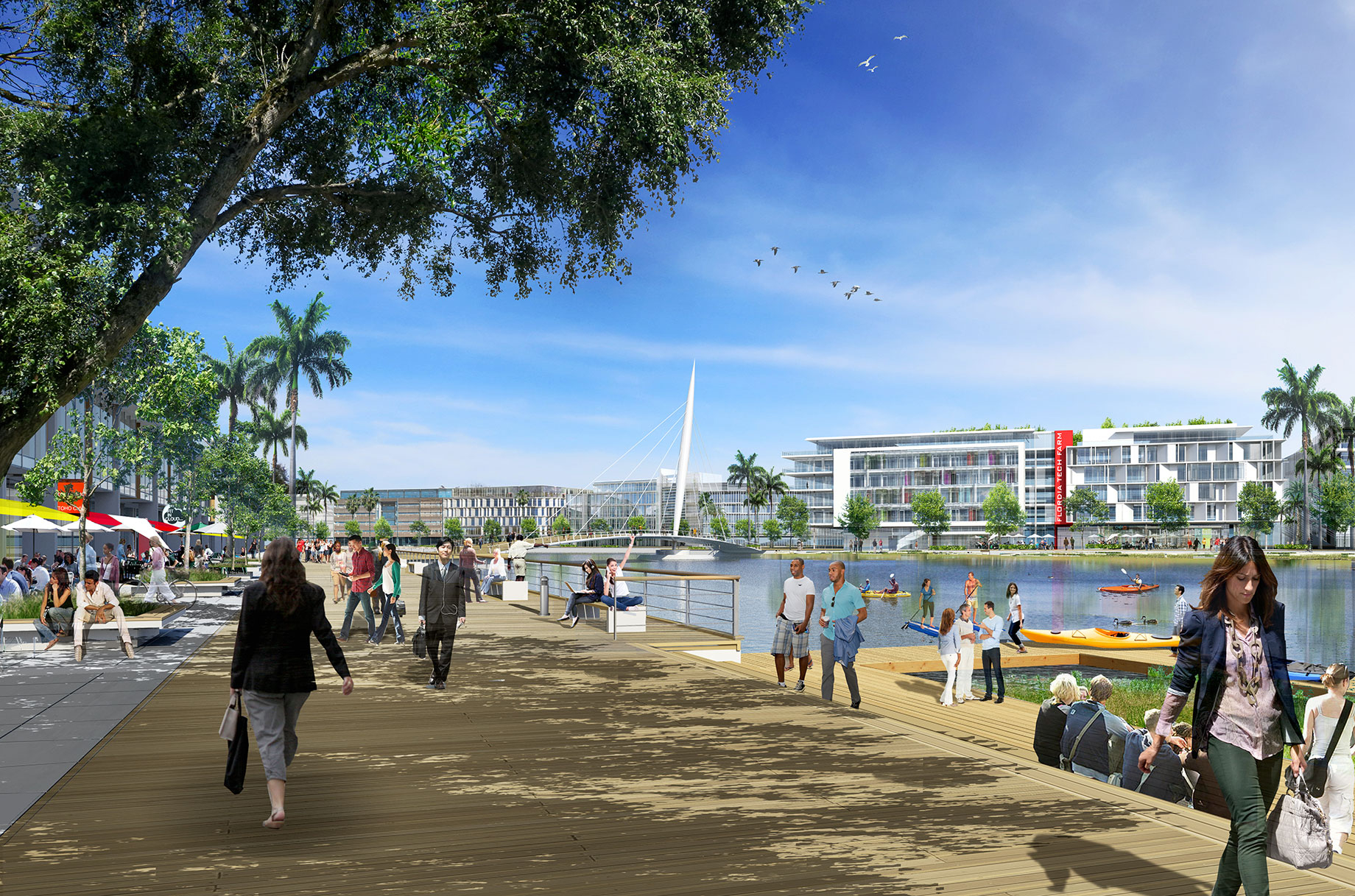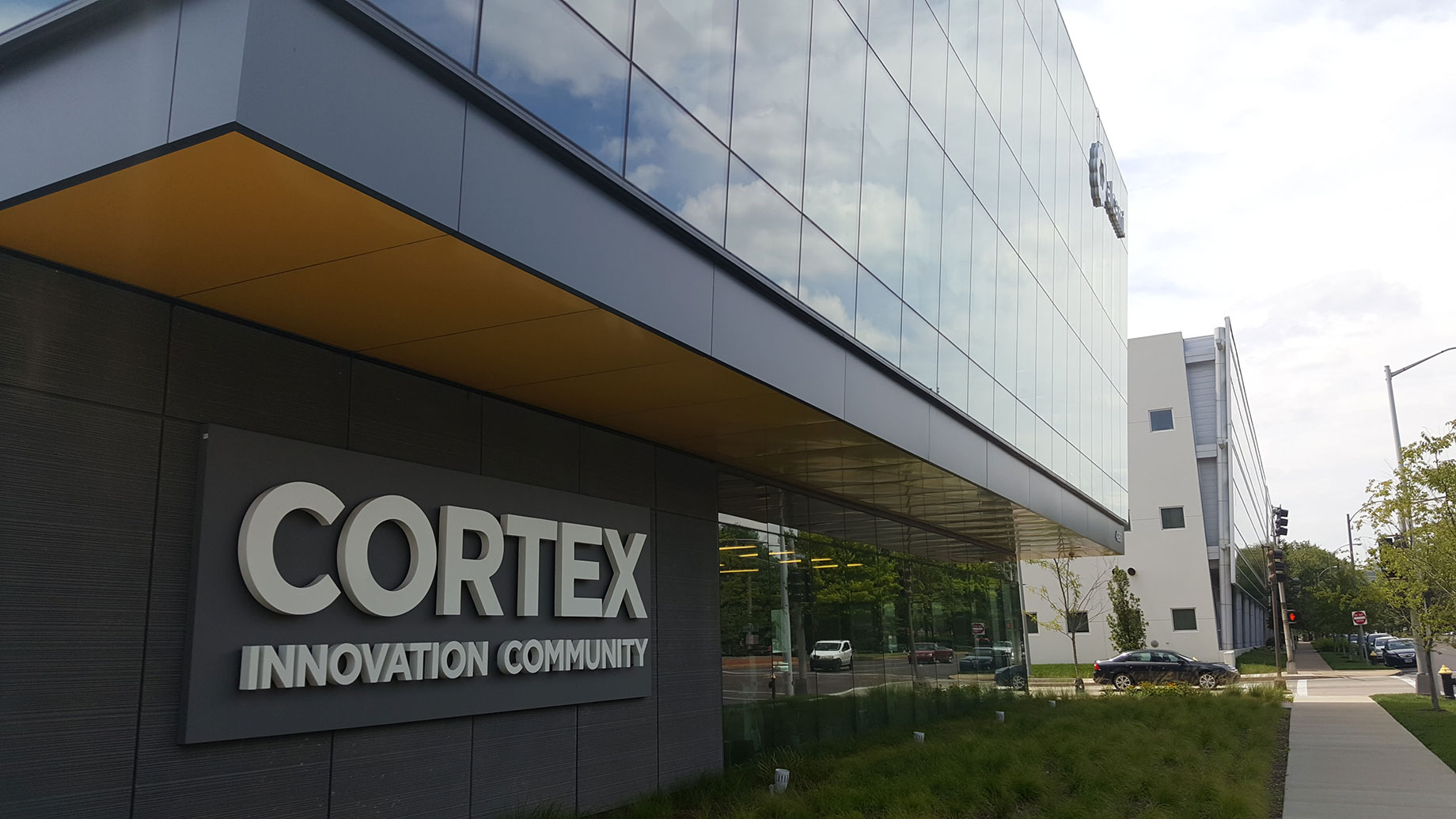Proponents of the innovation district have appropriated the “live, work, play” phrase and tweaked it — to “live, learn, work, play.” The updated refrain recasts innovation districts as economic development tools. Unlike their stale research-park forerunners, innovation districts foster collaboration, commercialization of academic discoveries and the growth of mixed-use communities.

Plans for NeoCity, on 483 acres south of Orlando, include a boardwalk and elements meant to create a sense of place
All this provides opportunities for restaurants and retailers, says Stephen Coulston, an urban-design specialist and a principal in the Austin, Texas, office of architecture firm Perkins and Will. The firm has provided planning for NeoCity, a district near Orlando, the Oklahoma City Innovation District and for the University of Florida Innovation District, formerly Innovation Square, among others. “In the ’70s, ’80s and ’90s, a lot of universities got into a real estate play and ended up emulating typical suburban office parks that were completely dead after 5,” said Coulston. “But now, innovation districts are moving toward a more urban street life, with bars, coffee shops, retail and programming. We’re trying to create spaces where people can bump into each other, which otherwise wouldn’t be the case.”
The $2.5 billion Cortex Innovation Community, near the Central West End and Forest Park Southeast neighborhoods of St. Louis, has embraced the mixed-use concept. Formed by nearby universities, medical institutions and other organizations in 2002, Cortex in 2012 adopted a plan, which remains ongoing, for public space, activity nodes and similar elements that create a sense of place on its 200-acre swath, which long had been industrial in character.

The number of workers at Cortex Innovation Community is expected to double over the next few years
The number of workers in the district, the vast majority of them research or office workers, is expected to double to about 15,000 over the next few years, says Dennis Lower, who was president and CEO of Cortex until the end of last year and who remains a consultant there. “The pace of growth has accelerated dramatically just in the last decade,” Lower said. “We have 430 companies, academic units and support businesses in the district, but we’re developing a mixed-use community, so retail is essential for that, as is residential.”
A handful of coffee shops and restaurants and a 15,000-square-foot fitness center currently serve these workers, says Lower. An Aloft hotel that is to include a music venue is scheduled to open in May. Additional restaurants and retailers will occupy space across a 262-unit multifamily project and two research and office buildings scheduled to break ground this year. Moreover, in 2015 Cortex attracted the only IKEA in St. Louis. The district applies the sales taxes this store generates toward infrastructure improvements and incentives for developers, notes Lower.
“In the ’70s, ’80s and ’90s, a lot of universities ... ended up emulating typical suburban office parks”
Several communities have launched innovation districts in hopes of tapping into employment and commerce opportunities. Over the past few years, some of these have appeared in Myrtle Beach, S.C.; Peoria, Ill.; and Springfield, Vt. For any given campus, however, the mass needed to support restaurants and retailers could take years to build, and proposals are prone to change. Plans for a town square at the Pittsburgh Airport Innovation Campus are in doubt, for instance, as that fledgling district has begun focusing on manufacturers with fewer employees, instead of office users and research organizations and labs.
The need for retail
Even so, innovation district proponents acknowledge that retail is needed to support tenants and marketing activities. Early place-making efforts frequently center on pop-up gathering places that feature food trucks and the like, such as Heart of the Park at the University of Utah Research Park, also called Bionic Valley, in Salt Lake City, says Coulston. Similarly, the University of Florida’s innovation district, near Gainesville’s downtown, has launched a temporary food-truck park, according to Trevor Schneider, University of Florida’s director of real estate. This effort is part of an overall plan to add workforce housing in that district and helps increase the tenant roster beyond the 80 businesses there now. “We don’t have the critical mass to have a lot of big names in retail here, but we ultimately see retail as being able to promote the area because having those types of amenities is important to office users,” said Schneider.
At a minimum, innovation district workers need places to gather for coffee in the morning and for booze after 5 p.m., argues Coulston. In fact, John Bardo, who was president of Wichita (Kan.) State University until his death last March and who spearheaded that school’s 120-acre Innovation Campus in 2014, made bringing in Starbucks a priority because that would help convey the university’s intent to succeed, recalls university spokesman Lou Heldman. That freestanding Starbucks opened in 2017. Two additional food-and-beverage operations, a credit union and a university bookstore have opened in Braeburn Square, a 20,000-square-foot retail project with room for expansion. The campus also includes a YMCA, and a Hyatt Place is set to open this year.
“We’re trying to create the conditions under which companies will want to come here [and] work with our researchers and hire our students while they’re still in school and after they graduate,” Heldman said. Wichita State officials visited North Carolina State University’s Centennial Campus district for inspiration.
“At a minimum, innovation district workers need places to gather for coffee in the morning and for booze after 5 p.m.”
Centennial Campus spans roughly 1,000 acres and is one of several separate but connected campuses that comprise this Raleigh-based university. Thus far, the Centennial Campus development includes a public golf course, a lake, a conference hotel and some nonstudent apartments and condominiums. The campus boasts a daytime population of about 14,000, primarily workers from the roughly 150 academic units, companies or government organizations that collaborate with the university, says Leah Burton, campus director for partnerships and industry alliances.
The number of retail and restaurant offerings is expected to grow beyond the dozen or so operating now, particularly as the university prepares to develop a 32-acre parcel for a denser mixed-use neighborhood in the district. Ultimately, this new development will incorporate more street-front amenities and activities, says Harlan Stafford, interim associate vice chancellor for real estate and development at North Carolina State. “We believe one of the first buildings will be an innovation hall that serves as a gathering place for students and professionals and that provides a number of different food venues, as well as retail,” Stafford said. “It’s not the type of development where you’re going to find a strip center.” Centennial Campus has hired personnel to oversee various types of community events and activities that have drawn people from surrounding neighborhoods.
There’s more in store at the Mid-Atlantic Conference & Deal Making
Register hereVirginia Tech, meanwhile, has found a home for its planned $1 billion innovation district at JBG Smith Properties’ 65-acre proposed North Potomac Yard mixed-use redevelopment, in Alexandria, Va. The site is about 260 miles north of the university’s main campus, in Blacksburg. Besides some 600,000 square feet of academic space, the first phase will include 122,000 square feet of retail and offices and 2,700 residential units.
The retail, however, will draw from the area’s dense population (the redevelopment is near JBG Smith’s Amazon HQ2 project, in Arlington’s Crystal City neighborhood), so it will not depend solely on the Virginia Tech innovation district. Still, this demonstrates that the once-incongruous notion of pairing retail with innovation districts is gaining acceptance, according to Michael Smith, director of real estate at Streetsense, a Bethesda, Md.–based branding-and-design firm that is working on North Potomac Yard.
“Whether it’s a student, faculty member or office worker, people want food-and-beverage, entertainment, fitness and other amenities close by,” said Smith. “These innovation districts are being reimagined as places that can be more dynamic, and it’s a win-win for all parties.”
By Joe Gose
Contributor, Commerce + Communities Today


